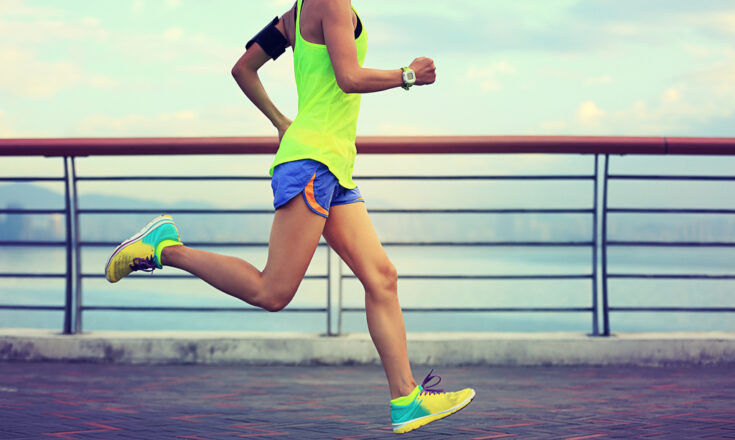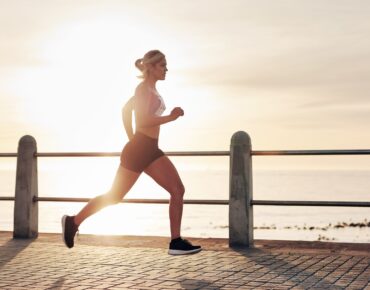When you run, you probably pay attention to your speed and distance. But what about your running cadence?
Your cadence can help you boost your speed and overall running performance. It can help you beat your personal best.
A study of cadence in elite ultramarathon runners during a 100-km road race found that the average running cadence of competitors was 182, while the total number of steps taken per minute ranged from 155 to 203.
180 steps per minute is a cadence many runners aspire to as it can improve running performance and may also help with preventing injuries and aid recovery.
The average cadence for beginners tends to be lower, which highlights the importance of becoming aware of your cadence and working to improve it.
So, let’s take a closer look at running cadence. What is it exactly? And how can you improve yours?
In This Article:
What Is Running Cadence?
Running cadence refers to the number of times your feet hit the ground in 1 minute. In other words, your steps per minute or step frequency.
Your cadence influences your speed, as a higher cadence often makes you run faster.
The more steps you’re taking when running, the less time you spend in the air. This contributes to a softer landing, which is better for your knees and other joints. Ideally, your feet should land under your center of gravity. This improves stride length and ensures your joints take less of a beating.
Recreational runners tend to have a cadence between 150 to 180 strides per minute (spm). Faster runners, as we’ve seen, often have a higher cadence. For example, Eliud Kipchoge, the marathon world record holder, is known to achieve a cadence of 190–200spm.
In general, 170–180spm is considered a great running cadence. Some consider it the ideal cadence for jogging as well. That said, it can be different for each runner.
Meanwhile, the average stride length varies from person to person, how fast one is moving, the terrain slope, and other factors.
Increasing your stride length, however, is not necessarily beneficial as it can lead to injury. A high stride length can increase the risk for stress fractures. Decreasing your stride length reduces the risk by up to 6%.
Ultimately, there’s no magic formula for calculating your ideal stride length.
How Can You Find Your Running Cadence?
Here’s how to determine your running cadence:
- As you run, count how many times your left or right foot hits the ground in 60 seconds.
- Double the result to figure out the total for both feet.
The quickest, easiest, and most accurate way to find your cadence is to track your cadence as you run through a running app that has a built-in cadence calculator.
The Joggo running app can be a great tool when it comes to tracking your running data and can help you find out your cadence with accuracy.
Tip: You want to track your cadence across different types of runs and terrains.
Why Should You Increase Your Running Cadence?
Focusing on cadence can help you improve your running technique even as you work on your gait.
Stride length affects both your cadence and running form. The shorter your stride length is, the quicker your stride rate, which often means a faster run. A low cadence is often the result of a long stride and an awkward running technique.
Increasing your running cadence could help with improving performance by boosting your running economy in long races, preventing injuries, and giving you a better running form.
A study on recreational runners found that slightly increasing your normal cadence may help prevent and treat common running injuries as well.
According to the study, a 5% cadence increase in runners running at a constant speed under various step rates can reduce the loading on the knees, whereas a 10% increase reduces loading on both the knees and hips.
How to Improve Your Running Cadence
Improving your cadence is a process. There are multiple cadence exercises and strategies you can try. Driving your arm back, using quick arms, and listening to running cadence songs as you run can also help.
Here’s more on how to increase cadence and avoid overstriding.
Focus on your stride
Focus on smaller steps, not on running faster. Aim for shorter, quicker steps. While this may feel unusual in the beginning, after a few runs, your body will adapt.
Your running stride and your cadence are linked. The faster your cadence, the shorter your running stride and vice versa. So, focusing on a proper running stride can help improve your cadence by leaps and bounds.
Overstriding is frequently associated with more impact and more force. This means that you’re more prone to injury and pain when you overstride.
What does overstriding mean exactly? Basically, it happens when the foot hits the ground far in front of the hips. This is what you don’t want to be doing.
Tip: Pay attention to where your foot lands. Try to spend less time in the air and avoid straightening your knee in front of you as you land. This can reduce your running stride and increase your cadence.
Run tall and dynamically balanced
To maintain an efficient stride, your feet need to land closer beneath you and push backward. Working only on your stride is often not enough to achieve this.
What you need is to make sure that your hips and glutes are strong. Sitting for long periods often weakens these muscles, which is why beginner runners often don’t run tall.
You want to run tall and balanced without leaning forward from the waist. If you’re not sure you have a good running form, lift your arms and reach up high above, careful not to go on tiptoes.
As you lower your arms, look at your feet to make sure you see the top of your shoelaces. Lean forward, moving your weight to your toes, and then swing your leg to start running. Maintain the same balance as you go.
Work out for quicker strides
Adding workouts for quicker strides to your training plan can also help you improve your running cadence.
Perform short sprints as these force you to practice going as quickly as you can while maintaining proper form and posture. Sprints also boost endurance and speed, so throw them into your training – they will help in more ways than one!
Also, try cadence drills like high knees, fast feet, A-skips, and butt kick drills. You can do these over a distance of 20 meters, 2 to 3 reps for each. At the end of each drill, walk back to where you started and do a new one.
Running on the spot is another good cadence drill:
- Run on the spot as fast as you can.
- Ensure your knees come up to 90 degrees.
- Aim to touch the ground as quickly as you can.
- Do this for 20 seconds, rest, then go again.
Use quick arms
The rhythm of your arms as you move can influence your cadence as well. You can use your arm swing to change your cadence, which can be easier for a beginner than working on gait alone. Moving your arms faster makes it easier to take quicker strides.
Drive your elbows back with quick, short swings. Keep your hands near your lower ribs and your elbows behind your hips.
You want to drive your arms back to keep the chest forward and encourage the feet to drive backward.
Run to a beat
Do you like listening to music when you run? You’ll love this one. Running cadence songs with 180 beats per minute is a great way to practice reaching the 180spm goal.
Find some music on your phone, plug in your headphones, and enjoy. You can find plenty of 180spm running music on YouTube.
The Bottom Line
You can improve your cadence by focusing on your stride and form, doing sprints and other cadence drills, and running to a beat.
In the end, working on your cadence can add variety to your training and help you spot things you can improve about your running form.
Improving your cadence will make you a better, faster runner. Once you reach a great cadence, it doesn’t end there. Keep working on it to maintain it!
Frequently Asked Questions
What is a good cadence for running?
A good running cadence for most runners falls between 170 and 180 steps per minute (SPM). However, it’s not a one-size-fits-all answer. Factors like height, leg length, running experience, and even footwear can influence your optimal cadence.
What is a bad running cadence?
Generally, a cadence significantly below 160 SPM or above 190 SPM is considered less efficient and could be a sign of issues:
- Below 160 SPM: This often indicates overstriding, where your foot lands far in front of your body, increasing impact and injury risk.
- Above 190 SPM: This can lead to choppy, bouncy strides, reducing your power and potentially causing muscle fatigue.
Is higher or lower cadence better?
Neither extreme is ideal. Aiming for a cadence within the 170-180 SPM range promotes:
- Efficiency: Shorter, quicker strides reduce ground contact time, minimizing impact and energy expenditure.
- Reduced injury risk: Lower impact forces lessen stress on your joints and muscles.
- Improved form: A higher cadence encourages a lighter footstrike and better posture.
Does cadence make you run faster?
While not a guaranteed speed booster, improving your cadence to a comfortable, efficient range can indirectly contribute to faster running. By reducing impact and improving running form, you might experience greater leg turnover and less energy wastage, leading to potentially faster paces.
Should you always run at the same cadence?
Not necessarily. Your cadence can naturally vary depending on the terrain, incline, and workout intensity.
- Uphill: Your cadence might decrease slightly as your stride shortens to handle the incline.
- Downhill: It might increase naturally as your leg turnover picks up with the descent.
- Interval training: During high-intensity bursts, your cadence may increase slightly due to faster leg turnover.
Remember, focus on finding a comfortable and efficient cadence that feels smooth and sustainable throughout your run. Don’t force a specific number; let your body guide you. If you suspect issues with your cadence, consult a running coach or physical therapist for personalized advice.
References:
- Hafer, J.F., Freedman Silvernail, J., Hillstrom, H.J. and Boyer, K.A., 2016. Changes in coordination and its variability with an increase in running cadence. Journal of sports sciences, 34(15), pp.1388-1395.
- Wellenkotter, J., Kernozek, T.W., Meardon, S. and Suchomel, T., 2014. The effects of running cadence manipulation on plantar loading in healthy runners. International journal of sports medicine, pp.779-784.
- Musgjerd, T., Anason, J., Rutherford, D. and Kernozek, T.W., 2021. Effect of increasing running cadence on peak impact force in an outdoor environment. International Journal of Sports Physical Therapy, 16(4), p.1076.
- Hafer, J.F., Brown, A.M., DeMille, P., Hillstrom, H.J. and Garber, C.E., 2015. The effect of a cadence retraining protocol on running biomechanics and efficiency: a pilot study. Journal of sports sciences, 33(7), pp.724-731.
- Fortmann, J., Pielot, M., Mittelsdorf, M., Büscher, M., Trienen, S. and Boll, S., 2012, September. PaceGuard: improving running cadence by real-time auditory feedback. In Proceedings of the 14th international conference on Human-computer interaction with mobile devices and services companion (pp. 5-10).














